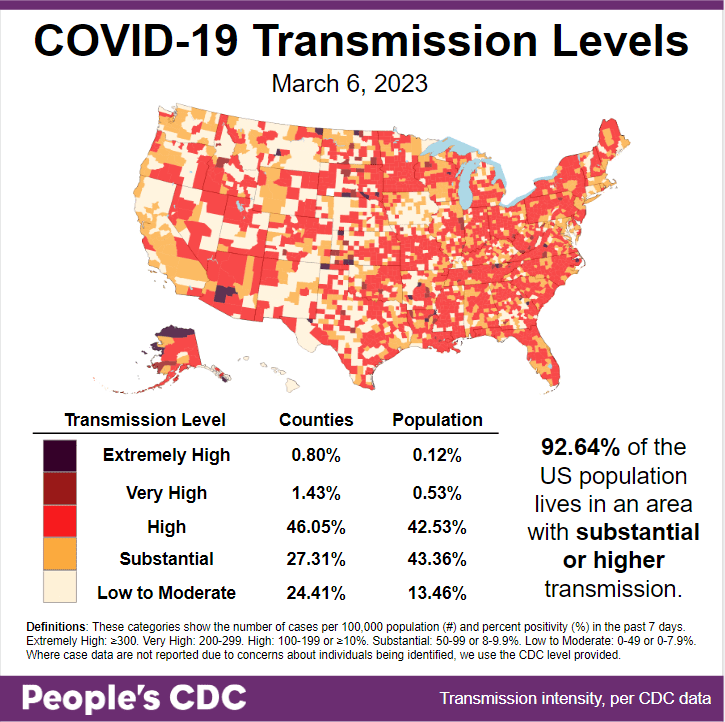The Weather: While transmission levels dropped slightly from last week, 86.54% of the population is living in areas with substantial or higher transmission.
Wins: The Illinois legislature is considering a bill that will adjust school policies to require ventilation assessments in all K-12 school settings with the addition of filters and carbon dioxide monitoring. This is one step towards adding layers of protection.
On Variants: This week, Kraken (XBB.1.5) makes up 89.6% of cases, surpassing the 85% of cases reported in last week’s Weather Report.

XBB.1.5 now represents more than 75 percent of all cases in each HHS region, and nearly 100% of all cases in the northeast.

Wastewater Monitoring: Wastewater levels appear to continue to slowly decrease or plateau across the country levels of COVID viral load still remain high indicating community spread.

The CDC’s MMWR published a study analyzing wastewater from international flights that found 81% of flights contained positive samples of COVID.
As airlines lobbied to abandon protections such as pre-flight testing, limiting capacity, and mask mandates as well as cut isolation periods to 5 days for workers, this comes as little surprise.
Hospitalizations: Hospitalizations for confirmed COVID cases remain high, with rates nationally remaining around 1 per 100,000 for all ages and around 5 per 100,000 for ages 70+.
Deaths: The week of March 1, 2023, 2,290 people have died of COVID nationally. At least 1,117,856 people have died from COVID in the US. Death data are to be considered incomplete due to processing delays indicating that the weekly counts may in fact be larger.
Long COVID: An article in Washington Post addressed the rise in postural orthostatic tachycardia syndrome (POTS) diagnosis among survivors of COVID, which has led to dizziness, fatigue, and irregular heartbeat.
A JAMA article published this week found elevated risk of adverse health events such as heart attack and stroke as well as elevated mortality over 12-month follow up among individuals with Long COVID compared to those with no evidence of COVID.
Forecast: NYPD is recommending business owners require patrons to remove their masks. It is clear that the NYPD has no interest in protecting the citizens of NYC. With over 45,000 COVID deaths, the city really needs mask and vaccine mandates, support for robust layers of protection including remote work and ventilation upgrades–NOT more policing.
California Department of Public Health shamefully updated their COVID policies to no longer require masks in health care settings and forcing workers back after 5 days of a positive COVID test, effective April 3.
We believe that workers need paid time to recover from infection of at least 10 days and masks should be mandated in all indoor settings, including health care, to prevent infection.
Take Action: Tell the White House COVID Response Coordinator to tell the truth about Long COVID! Sign the letter here!
March 6th is National COVID Memorial day. Take action here!
Notes: 1) The numbers in this report were current as of 3/4. The CDC updates data frequently as it receives refreshed information. Today’s numbers may be slightly different from the data here. 2) Check out the links throughout & see our website for more! https://peoplescdc.org




